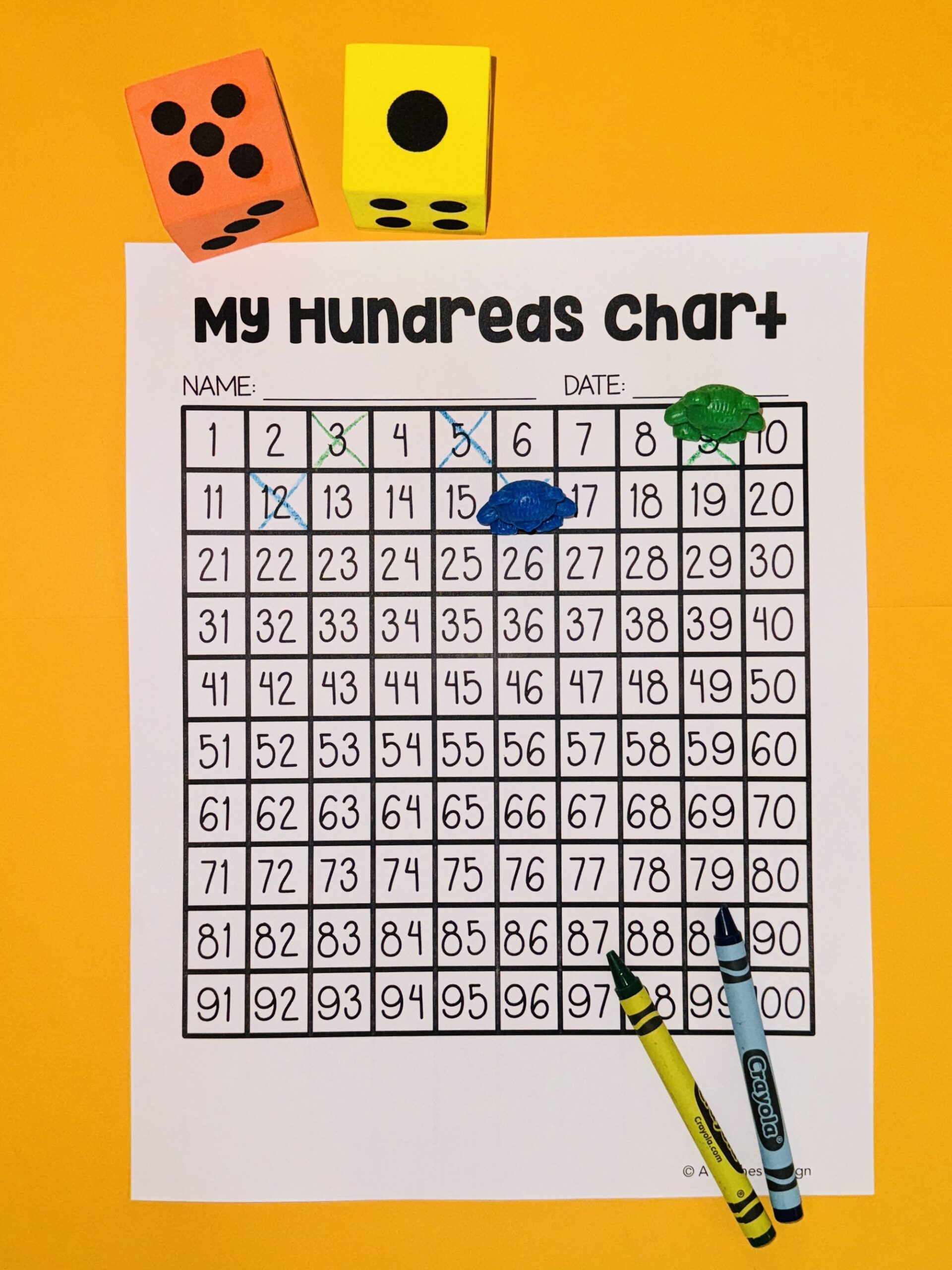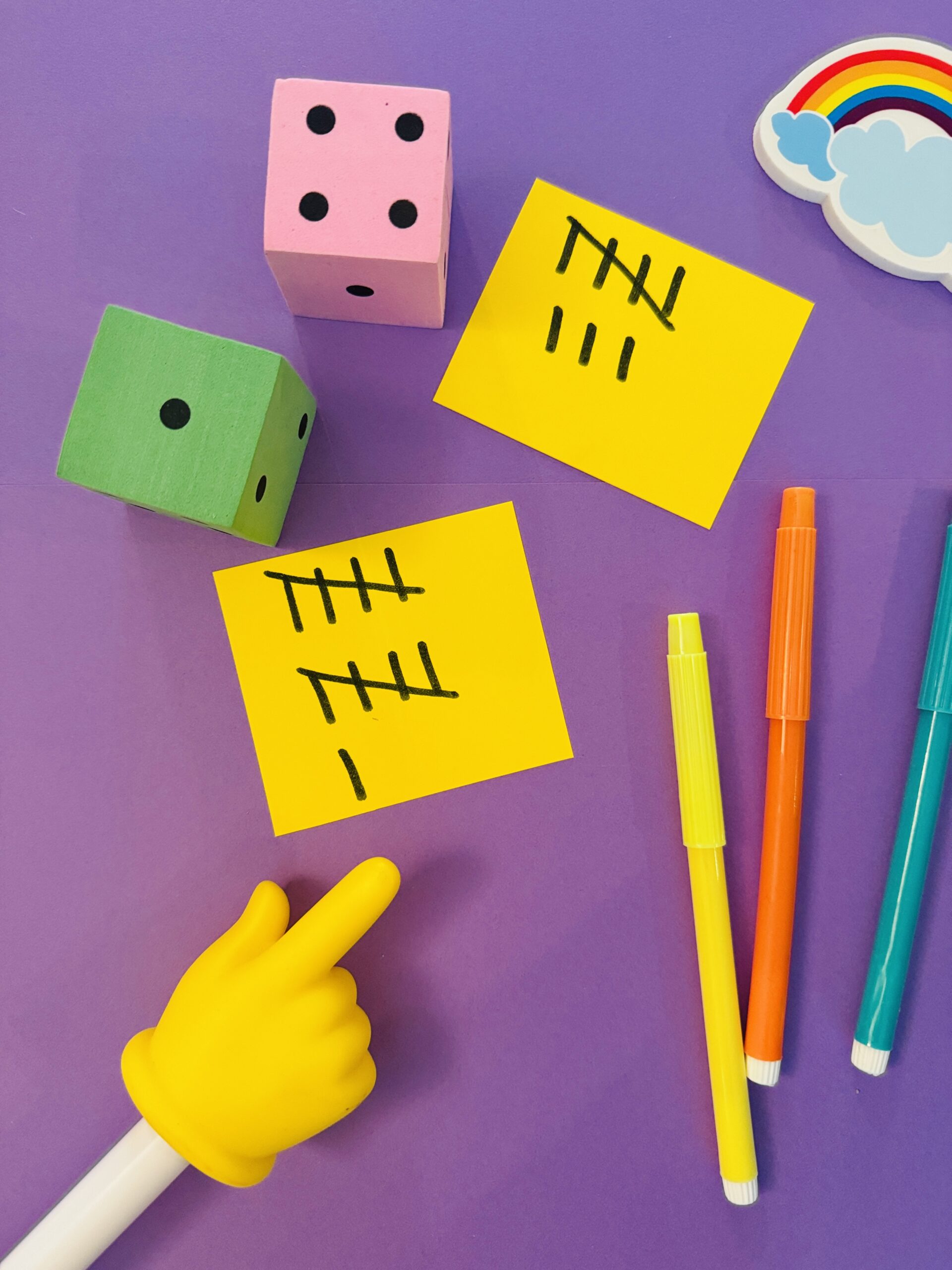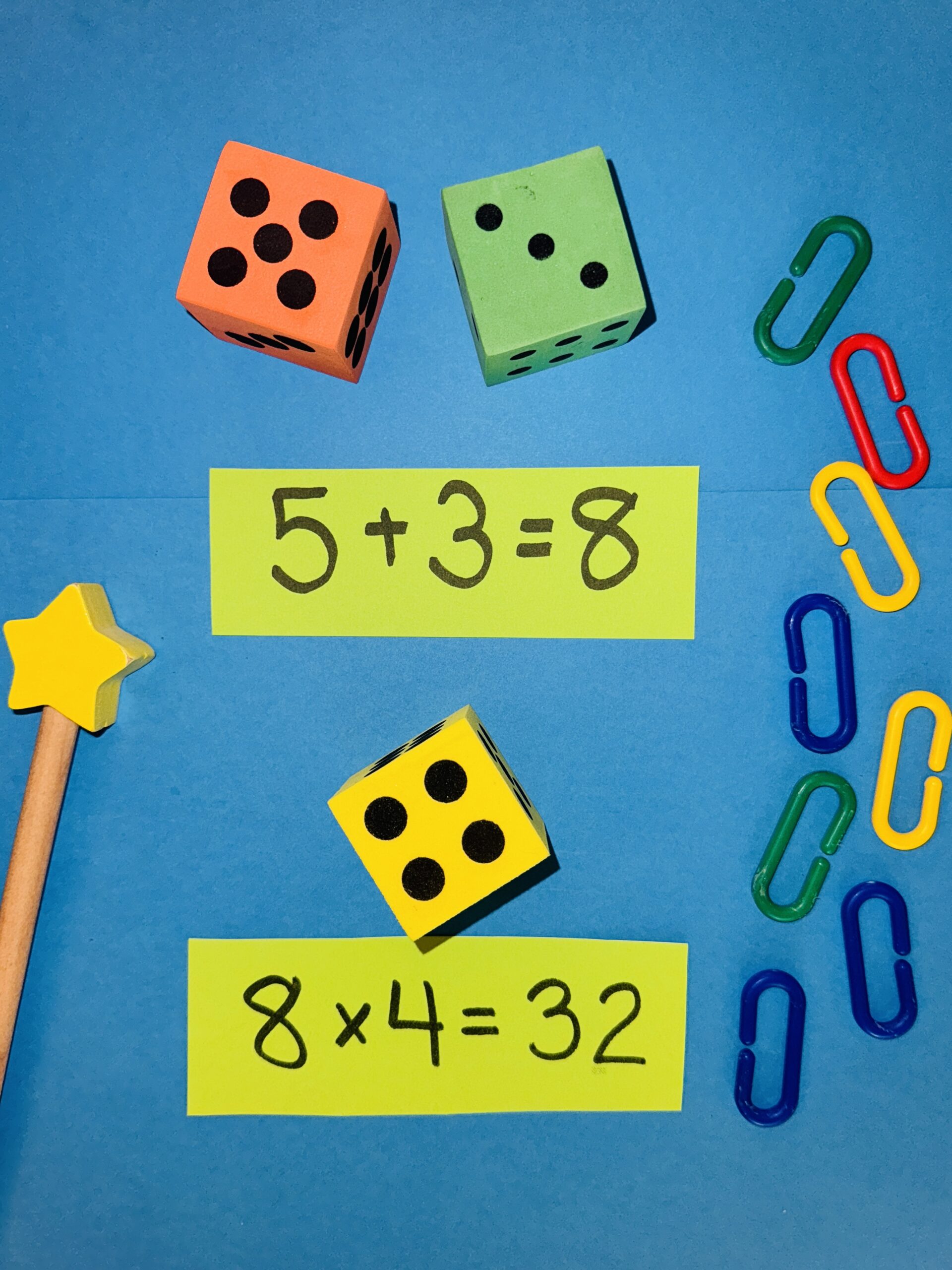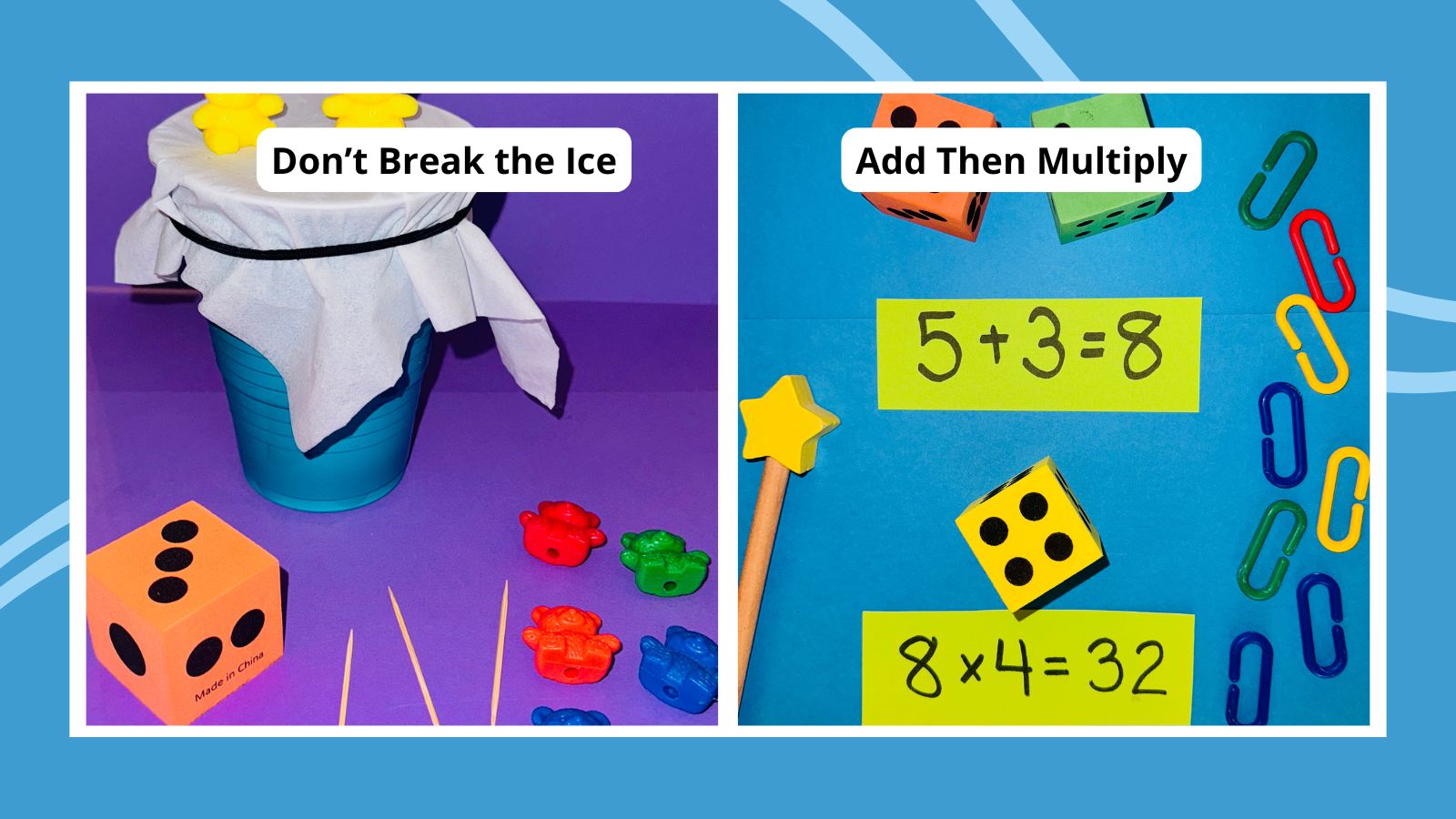There’s something about dice that kids like. They’re very hands-on, and there’s the fun of rolling them for whatever reason. They’re also easy to understand. You don’t even need to recognize numerals, you just need to be able to count dots. And there are so many games to play with dice! Here are 20 easy-to-understand, fun dice games to help your students learn various math concepts while rolling along and having some fun.
1. Getting To Know You
Looking for dice games to use at the beginning of the school year? This game doubles as an icebreaker. Use one die and a sheet with six numbered questions on it. Each number on the die will correspond to a question. The questions help students get to know one another. You can prepare them beforehand, or they can be generated by the class. Players take turns rolling the die. Whatever number comes up, they answer the corresponding question, then pass the die to the right. If you get the same number twice, you can roll again or just share one other interesting fact about yourself. Some sample questions:
- Which fictional character would you like as a friend?
- If you could go anywhere in the world, where would you go?
- If you could only eat one food for the rest of your life, what would it be?
2. Climb the Mountain
Students play in pairs and share three dice. Each player needs a piece of paper with a mountain drawn on it with numbers 1 through 18 written along the mountain edge.
Players take turns rolling the dice and using the numbers that come up to make addition or subtraction problems whose answers are numbers on the mountain. Make as many as you can from your roll. The answer numbers on the mountain are crossed out with each turn and then the other player goes. The player whose mountain is empty of numbers first is the winner.
To make it more challenging, the players must create problems that give the numbers on the mountain in order.
3. Dice Battle
Pair up students with two pairs of dice each and a collection of small items (counting bears, blocks, pom-poms, etc.). Both players roll their dice and add their own up. Whoever has the highest answer takes an item from the other player. The battle can end when one player has no items left, after a set number of battles, after a set amount of time, or when the teacher calls “battles over.”
4. Coin Roll
Students can work independently or with a partner in this activity. They’ll need a pair of dice and a sheet with three columns: The first column shows the two dice as rolled for each turn. The second column will show the total value of both dice numbers. The third column will show the coins that can be used for that money value.
For example, you roll a 6 and a 3. You draw the die in column 1. In the second column, you write 6 + 3 = 9, and in the third column, you write the fewest coins you could use to make that amount. In this case, a nickel and four pennies.
5. Going to Boston
Looking for classic dice games? Try Going to Boston. It can be played by two or three players. Students will need three dice and a sheet to record their totals in each round. To decide who goes first, let them each roll a single die, and whoever rolls the highest number goes first.
A player rolls all three dice, and the highest number die is put aside. The player now rolls the two remaining dice, takes the higher of those two, and puts it aside. Finally, they roll the last die, then put it aside.
The player adds up all three dice, and that is their total for that round. Record the total for that player on the sheet. Now it’s the next player’s turn to do the same.
If there is a tie in a round, the tying players roll all three dice again. Play a set number of rounds until the time is up. Add up the totals from each round to determine the winner of the game. If at the end of these dice games, there is a tie, the tying players roll all three dice again.
6. Rolling to Six
This number-sequence game is played in pairs. Each player gets a single die. They both roll their die, and when a player rolls a 1, the game begins. From that 1, that player continues to roll until they get a 2, then 3, continuing to 6. The other player must also roll a 1 and continue rolling to get numbers 2 through 6. Whoever reaches 6 first is the winner.
7. Roll and Tell
This is a fun way of talking about a story or book you’ve just read. This dice game can be done with the whole class or in groups. After reading a book, show students the chart with the dice and corresponding questions:
- What was the book mainly about?
- Who were the main characters?
- What was the problem in the story?
- Where and when does the story take place?
- How was the problem solved?
- What was your favorite part of the story?
Have a student roll the die, and the student or the group will answer that number question. Make up your own questions that work best for your students.
8. Fives and Twos
This addition game can be played in pairs or in small groups. All that is needed is five dice and a sheet to record players’ totals for each round.
A player rolls all five dice at the same time. If a 5 or a 2 is rolled, put those aside. The player continues to roll the remaining dice until all dice show a 5 or 2. The players then add their dice up on the recording sheet. Whoever has the highest score for the round is the winner.
9. Fishing Boat Catch
Five dice are needed for this game. A player will roll all five dice at the same time, up to three times, to get a 6 for the Boat, a 5 for the Captain, and a 4 for the Crew. Those are required to go fishing! Once those three are rolled, the Catch is the total of the remaining two dice. (If the 6, 5, and 4 are not rolled after three attempts, the next player rolls.)
Then it’s the next player’s turn. When everyone has had a turn, the player with the highest Catch wins.
10. Don’t Break the Ice

Provide each player with a plastic cup and use a rubber band to secure a tissue across the opening. Players will also need a toothpick, one die, and small objects (counting bears, LEGO, connecting blocks). Each player takes a turn rolling the dice. If a 2 to 6 is rolled, poke that number of holes in the tissue. If a 1 is rolled, put one of the small objects on the tissue, or if a player’s items fall into the cup, they are out of the game! Continue playing until all the players are out.
11. Perimeter Roll
Pairs of players will need a pair of dice, graph paper, and one colored pencil each (two different colors). A player rolls the dice and uses the two numbers to draw a box that length and width on the graph paper using their colored pencil. For example, if you roll a 3 and a 5, the perimeter will be 3 + 5 +3 + 5. Draw that rectangle using the colored pencil. (Players can color it in.) The next player does the same and draws their box on the graph paper in their color.
Once there is no more room on the graph paper to add any more boxes, the game is over. Players then compute the area of their own boxes and add them up. The player with the most area is the winner.
12. Roll a Funny Face
Engage your artistic students with dice games that incorporate drawing. To play this one, create a chart that has:
- Six boxes across the top of the chart, each one with a dice dot amount 1 through 6.
- Six boxes along the left side of the chart, each one with the terms “Turn 1: face shape, Turn 2: eyes, Turn 3: nose, Turn 4: mouth, Turn 5: ears, Turn 6: hair.”
- Inside the chart across from each Turn, draw choices of those features: different shapes, types of faces, eyes, noses, etc., in silly cartoon designs or animal-like styles.
As the players roll their single die, they will have to read and follow the chart to draw the funny face on a sheet of paper with crayons, markers, or colored pencils.
For example, on Turn 1, you roll a 4, find the face shape for a 4, and draw that face shape. Turn 2, roll a 6, find the eyes for a 6, and draw those eyes.
This can be done independently, in pairs, or in groups. It’s fun to see the final results.
13. Roll and Add to 100

Pairs of players will need a 100s chart, a pair of dice, and a crayon, marker, or colored pencil (different from each other).
Players roll the dice, add the two numbers together, put an “X” on that spot on the chart, then move ahead that many spaces and put another “X” on that one. Then it is the other player’s turn.
For example, the first player rolls 3 and 5. They put a blue X on 8, then move ahead eight more spaces and put another blue X on 16. That ends that turn. Now it’s the next player’s turn.
Continue playing until one player reaches 100.
14. Don’t Roll a One!
Pairs of players will need a pair of dice and a sheet of lined paper to tally their rolls.
Each player rolls the dice, adds up the total, and records using tally marks. The player can continue to roll the two dice and add up as many times as they like in each turn, stopping when ready, keeping in mind that if they roll a 1, they lose all the points from that turn.
Winning can be determined by a given total number/score, the number of rounds, or a time limit.
15. Point Number

Pairs of students will need a pair of dice and a sheet of lined paper to tally their scores. Each player rolls the dice. The player with the higher number will go first, and the player with the lower number will roll again to set the “Point Number.”
Once the Point Number is set, the first player rolls both dice. If the point number was rolled, the player gets one point. If double the Point Number was rolled, the player gets two points. No points are scored unless they are the Point Number or double the Point Number.
The first player to get 11 points wins.
16. Roll a High Quotient
Playing in pairs or small groups, students will need three dice and a sheet of paper to record answers.
To play, a player rolls the three dice and chooses two of them to be the double-digit dividend and the third one to be the divisor. The object is to make the largest quotient possible. Each player records their quotients and adds them up at the end of the game. If a quotient comes out evenly, with no remainder, that player gets a bonus of 10 extra points. If there is a remainder, write that down, but do not use it in the final tally. The player with the highest total wins.
For example, you roll 2, 4, and 6. Use 6 and 4 to be the dividend 64 and use 2 to be the divisor. 64 divided by 2 equals 32. That’s your score.
17. Make a Run
This is one of the dice games that can be played with two or more players. Players will need six dice and a sheet of paper to record scores.
A player rolls all six dice and tries to make a “run.” A run is any number in sequence, including odd/even numbers, and multiples. You need at least three numbers in sequence to be considered a run. For each number in the run, a player earns five points. A die can only be used in one run. But a player can create more than one run in a turn. Play until a player reaches 100 points.
For example, a player rolls 2, 4, 6, 3, 3, 1. A possible run could be 1, 2, 3, 4 (in sequence), scoring 20 points, and 3, 6 (multiples), scoring 10 points for a total of 30 points in that round.
18. Add Then Multiply

Pairs of players need three dice and a sheet to record scores (and possibly some calculations). On their turn, a player will roll all three dice, adding two of them together and multiplying by the third one. Each player records their score for each round on the sheet. At the end of the game, players will add up the scores from all their rounds. Highest score wins. For example, if you roll 3, 4, and 2, you could add 2 and 4 together and get 6. You would then multiply 6 by the remaining number, 3, so 6 x 3 = 18.
Play can go to a certain score, a certain number of rounds, or a set amount of time.
19. Ten Multiples
This can be played in pairs or small groups. Provide one pair of dice for the players to share and a sheet of paper for each player.
A player rolls the two dice and adds them together. They use that sum as the first in a series of 10 multiples of that sum. For example, if you roll a 3 and a 4, the sum is 7. The multiples of 7 are: 7, 14, 21, 28, 35, 42, 49, 56, 63, and 70.
The teacher can decide at some point to have students do this orally rather than on paper.
20. Fishy Addition or Multiplication
Each student will need crayons or colored pencils and a prepared sheet with outlines of fish (teacher is to decide on that number) and a sum or product written on the fish. The numbers will be determined by whether the skill is addition or multiplication.
A student rolls the dice, adds or multiplies the two numbers, and colors in the fish that corresponds to the answer.

